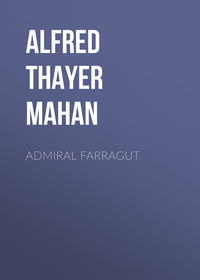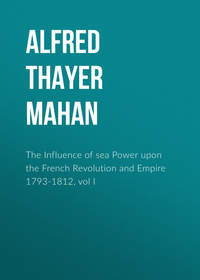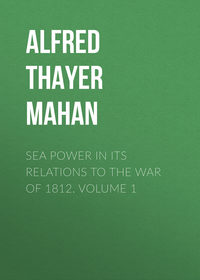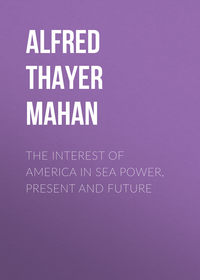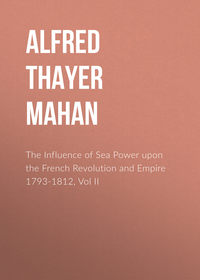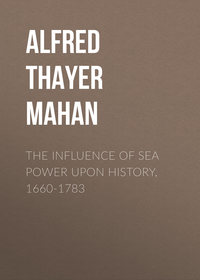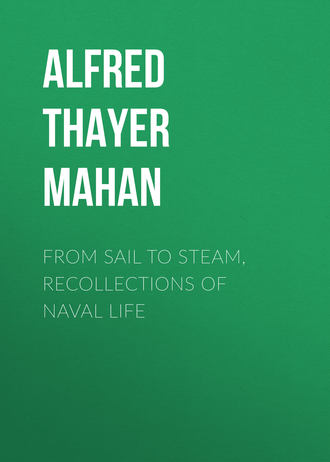 полная версия
полная версияFrom Sail to Steam, Recollections of Naval Life
The midshipman's berth, as attested by contemporary sketches, was peopled by all sorts in age, fitness, and manners. In one of the many tales I devoured in youth, a middle-aged shellback of a master's mate, come in from before the mast, says with an oath to an aristocratic midshipman: "Isn't my blood as red as yours?" Still, even in the British navy, with its fine democratic record, the social rank was more regarded than the military. His Majesty's ship So-and-So was commanded by John Smith, Esquire; and I have heard this point of view stated by competent authority as accounting for the address—George Washington, Esquire—placed by Howe on the letter which Washington refused to accept because not carrying the rank conferred on him by Congress. This does not, however, explain away the "etc., etc.," which followed on the cover. John Byng, Esquire, Admiral of the Blue, would thus be of higher consideration as Esquire than as Admiral. Even in our own service I remember an old log, the pages of which were headed, "Cruise of the U. S. Ship Preble, commanded by J. B. M–, Esquire."
In the practice cruises the social question did not arise. Independent of the democratic tendency of all boys' schools, where each individual finds his level by natural gravitation, the Naval Academy, for reasons before alluded to, has been remarkably successful in assimilating its heterogeneous raw material and turning out a finished product of a good average social quality. Beyond this, social success or failure depends everywhere upon personal aptitudes which no training can bestow. But as officers we were nondescript. There were too many of us; and for the most the object was to acquire a sufficient seaman's knowledge, not an officer's. Yet, curiously enough, so at least it seemed to me, there was a disposition on the part of some to be jealous of any supposed infringement of our prerogative to be treated as "a bit of an officer." Ashore or afloat, we made our own beds or lashed our own hammocks, swept our rooms, tended our clothes, and blacked our boots; our drills were those of the men before the mast, at sails and guns; all parts of a seaman's work, except cleaning the ship, was required and willingly done; but there was a comical rebellion on one occasion when ordered to pull—row—a boat ashore for some purpose, and almost a mutiny when one lieutenant directed us to go barefooted while decks were being scrubbed, a practice which, besides saving your shoe-leather, is both healthy, cleanly, and, in warm weather, exceedingly comforting. Some asserted that the lieutenant in question, who afterwards commanded one of the Confederate commerce-destroyers, and from his initials (Jas. I.) was known to us as Jasseye, had done this because he had very pretty feet which he liked to show bare, and we must do the same; much as Germans are said to train their mustaches with the emperor's. At all events, there was great wrath, which I supposed I should have shared had I not preferred bare feet—not for as sound reasons as the lieutenant's. It stands to reason, however, that that imputation was slanderous, for there were no appreciative observers, unless himself. Why waste such sweetness on the desert air of a lot of heedless midshipmen? With so many details regulated—if not enforced—from the length of our hair to the cut of our trousers, it did seem hypercritical to object to going shoeless for an hour. But who is consistent? The uncertainty of our position kept the chip on the shoulder.
V
MY FIRST CRUISE AFTER GRADUATION—NAUTICAL CHARACTERS
1859–1861At the moment of graduation, in the summer of 1859, I had a narrow escape from the cutting short of my career, resembling that which a man has from a railway accident by missing the train. To a certain extent the members of classes were favored in forming groups of friends, and choosing the ship to which they would be sent. Myself and two intimates applied for the sloop-of-war Levant, destined for the Pacific by way of Cape Horn; our motive being partly the kind of vessel, supposed by us to favor professional opportunity, and partly the friendship existing between one of us and the master of the Levant, a graduate of two or three years before, who had just completed his examinations for promotion. Luckily for us, and particularly for me, as the only one of the three who in after life survived middle age, the frigate Congress was fitting out, and her requirements for officers could not be disregarded. The Levant sailed, reached the Pacific, and disappeared—one of the mysteries of the deep. We very young men had the impression that small vessels were better calculated to advance us professionally, because, having fewer officers, deck duty might be devolved on us, either to ease the regular watch officers or in case of a disability. This prepossession extended particularly to brigs, of which the navy then had several. This was a pretty wild imagining, for I can hardly conceive any one in trusting such a vessel to a raw midshipman. It is scarcely an exaggeration to say they were all canvas and no hull—beautiful as a dream, but dangerous to a degree, except to the skilful. As it was, an unusual proportion of them came to grief. Our views were doubtless largely, if unconsciously, affected by the pleasing idea of prospective early importance as deck officers. The more solid opinion of our seniors was that we would do better to pause awhile on the bottom step, under closer supervision; while as for vessel, the order, dignity, and scale of performance on big ships were more educative, more formative of military character, which, and not seamanship, is the leading element of professional value. "Keep them at sea," said Lord St. Vincent, "and they can't help becoming seamen; but attention is needed to make them learn their business with the guns." I have already mentioned that, at the outbreak of the War of Secession, it was this factor which decided the authorities to give seniority to the very young lieutenants over the volunteers from the merchant service, most of whom had longer experience and (though by no means all of them) consequent ability as seamen.
After graduating, my first cruise was upon what was then known as the Brazil Station; by the British called more comprehensively the Southeast Coast of America. After the war the name and limits were judiciously changed. It became then the South Atlantic Station, to embrace the Cape of Good Hope, and, generally, the coasts of South America and Africa, with the islands lying between, such as St. Helena and the Falklands. From the point of view of healthy activity for the ships and their companies, and specifically for the education of younger officers, this extension was most desirable. In the earlier time long periods were spent in port, because there really was not enough that required doing. Our captain once kept the ship at sea for a fortnight or more, "cruising;" that is, moving about within certain limits back and forth. In war-time this is frequent, if not general; but then it is for a specific purpose, conducive to the ends of war. In peace, cruising ends in itself; it is like a "constitutional;" beneficial, no doubt, but not to most men as healthily beneficial as the walk to the office, with its definite object and the incidental amusement of the streets. A terminus ad quem is essential to the perfection of exercise, bodily or mental. As it was, Montevideo, in the river La Plata, and Rio de Janeiro were the two chief ports between which we oscillated, with rare and brief stays elsewhere or at sea.
The Congress was a magnificent ship of her period. The adjective is not too strong. Having been built about 1840, she represented the culmination of the sail era, which, judged by her, reached then the splendid maturity that in itself, to the prophetic eye, presages decay and vanishment. In her just but strong proportions, in her lines, fine yet not delicate, she "seemed to dare," and did dare, "the elements to strife;" while for "her peopled deck," when her five hundred and odd men swarmed up for an evolution, or to get their hammocks for the night, it was peopled to the square foot, despite her size. On her forecastle, and to the fore and main masts, each, were stationed sixty men, full half of them prime seamen, not only in skill, but in age and physique—ninety for the starboard watch, and ninety for the port; not to count the mizzen-topmen, after-guard, and marines, more than as many more. I have always remembered the effect produced upon me by this huge mass, when all hands gathered once to wear ship in a heavy gale, the height of one of those furious pamperos which issue from the prairies (pampas) of Buenos Ayres. The ship having only fore and main topsails, close reefed, the officers, beyond those of the watch, were not summoned; the handling of the yards required only the brute force of muscle, under which, even in such conditions, they were as toys in the hands of that superb ship's company. I had thus the chance to see things from the poop, a kind of bird's-eye view. As the ship fell off before the wind, and while the captain was waiting that smoother chance which from time to time offers to bring her up to it again on the other side with the least shock, she of course gathered accelerated way with the gale right aft—scudding, in fact. Unsteadied by wind on either side, she rolled deeply, and the sight of those four hundred or more faces, all turned up and aft, watching intently the officer of the deck for the next order, the braces stretched taut along in their hands for instant obedience, was singularly striking. Usually a midshipman had to be in the midst of such matters with no leisure for impressions—at least, of an "impressionist" character. Those were the prerogatives of the idlers—the surgeon, chaplain, and marine officers—who obtained thereby not only the benefit of the show, but material for discussion as to how well the thing had been done, or whether it ought to have been done at all. The midshipman's part at "all hands" was to be as much in the way as was necessary to see all needed gear manned, no skulkers, and as much out of the way as his personal stability required, from the rush of the huge gangs of seamen "running away" with a rope.
I never had the opportunity of viewing the ship from outside under way at sea; but she was delightful to look at in port. Her spars, both masts and yards, lofty and yet square, were as true to proportion, for perfection of appearance, as was her hull; and the twenty-five guns she showed on each broadside, in two tiers, though they had abundance of working-room, were close enough together to suggest two strong rows of solid teeth, ready for instant use. Nothing could be more splendidly martial. But what old-timers they were, with the swell of their black muzzles, like the lips of a full-blooded negro. Thirty-two-pounders, all of them; except on either side five eight-inch shell guns, a small tribute to progress. The rest threw solid shot for the most part. Imposing as they certainly looked, and heavier though they were than most of those with which the world's famous sea-fights have been fought, they were already antediluvian. A few years later I saw a long range of them enjoying their last repose on the skids in a navy-yard; and a bystander, with equal truth and irreverence, called them pop-guns. One almost felt that the word should be uttered in a whisper, out of respect for their feelings. But the whole equipment of the ship, though up to date in itself, was so far of the past that I recall it with mingled pathos and interest. What naval officer who may read these words was ever shipmate with rope "trusses" for the lower yards, or with a hemp messenger? A "messenger" was a huge rope, of I suppose eighteen to twenty-four inches circumference, used for lifting the anchor. At the after end of the ship it was passed three times round the capstan, where the men walking round merrily to the sound of the fife, under the eyes of the officer of the deck, were doing the work of weighing; at the forward end it moved round rollers to save friction. Thus one part was taut under the strain of the capstan; and to this the cable of the anchor, as it was hove in, was made fast by a succession of selvagees, for which I will borrow the elaborate description of White Jacket, who tells us the name was applied by the seamen of his ship to one of the lieutenants: "It is a slender, tapering, unstranded piece of rope, prepared with much solicitude; peculiarly flexible; which wreathes and serpentines round the cable and messenger like an elegantly modelled garter-snake round the stalks of a vine." The messenger thus was appropriately named; it went back and forth on its errand of anchor raising, the slack side being helped on its way by a row of twelve or fifteen men seated, pulling it along forward. This gang, by immemorial usage, was composed of the colored servants, and I can see now that row of black faces, with grinning ivories, as they yo-ho'd in undertones together, "lighting forward the messenger."
Like the ship and her equipment, the officers and crew by training and methods were still of the olden time in tone and ideals; a condition, of course, fostered at the moment by the style of vessel. Yet they had that curious adaptability characteristic of the profession, which afterwards enabled them to fall readily into the use of the new constructions of every kind evolved by the War of Secession. Concerning some of these, a naval professional humorist observed that they could be worshipped without idolatry; for they were like nothing in heaven, or on earth, or in the waters under the earth. Adored or not, they were handled to purpose. By a paradoxical combination, the seaman of those days was at once most conservative in temperament and versatile in capacity. Among the officers, however, there was an open vision towards the future. I well remember "Joe" Smith enlarging to me on the merits of Cowper Coles's projected turret ship, much talked about in the British press in 1860; a full year or more before Ericsson, under the exigency of existing war, obtained from us a hearing for the Monitor. Coles's turrets, being then a novel project, were likened, explanatorily, to a railway turn-table, a very illustrative definition; and Smith was already convinced of the value of the design, which was proved in Hampton Roads the day after he himself fell gloriously on the deck of the Congress. There is a double tragedy in his missing by this brief space the clear demonstration of a system to which he so early gave his adherence; and it is another tragedy, which most Americans except naval officers will have forgotten, that Coles himself found his grave in the ship—the Captain—ultimately built through his urgency upon this turret principle. This happened in 1870. The tradition of masts and sails, as economical, still surviving, she was equipped with them, which we from the beginning had discarded in monitors. The Captain was a large vessel with low freeboard, her deck only six feet above water. Lying to under sail in a moderate gale, in the Bay of Biscay, she heeled over in a squall, bringing the lee side of the deck under water; and the force of the wind increasing, without meeting the resistance offered ordinarily by the pressure of the water against the lee side of a ship, she went clean over and sank. The incident made the deeper impression upon me because two months before I had visited her, when she was lying at Spithead in company with another iron-clad, the Monarch, which soon after was assigned by the British government to bring George Peabody's remains to their final resting-place in America. I then met and was courteously received by the captain of the Captain, Burgoyne, of the same family as the general known to our War of Independence. Coles had gone merely as a passenger, to observe the practical working of his designs. I do not know how far the masting was consonant to his wishes. It may have been forced upon him as a concession, necessary to obtain his main end; but nothing could be more incongruous than to embarrass the all-round fire of turrets by masts and rigging.
In 1859 the United States government was coquetting with the title "Admiral," which was supposed to have some insidious connection with monarchical institutions. Even so sensible and thoughtful a man as our sailmaker, who was a devout disciple and constant reader of Horace Greeley, with the advanced political tendencies of the Tribune, said to me: "Call them admirals! Never! They will be wanting to be dukes next." We had hit, therefore, on a compromise, quite accordant with the transition decade 1850–1860, and styled them flag-officers; concerning which it might be said that all admirals are flag-officers, but all flag-officers were not admirals—not American flag-officers, at all events. As a further element in the compromise, instead of the broad swallow-tailed pendant of a commodore, our previous flag-rank, we carried the square flag at the mizzen indicative in all navies of a rear-admiral, to which we gave a rear-admiral's salute of thirteen guns, and expected the same from foreigners; while all the time the recipient stood on our Navy Register as a captain, only temporarily brevetted Flag-officer. Well do I remember the dismay of our flag-officer when, quitting a British ship of war, she fired the customary salute, and stopped at eleven—a commodore's perquisite. The hit was harder, because the old gentleman was particularly fond of the English, having received from them great hospitality incidental to his commanding the ship of war which carried part of the American exhibition to the World's Fair of 1851. An "Et tu, Brute" expression came over his face, as he sank back with a sorrowful exclamation in the stern-sheets of the barge, which, as nautical convention requires, was lying motionless, oars horizontal, a ship's-length away; when, lo and behold, as a kind of appendix to the previous proceedings, bang! bang! went two more guns, filling the baker's dozen. It was, of course, somewhat limping, but the apology was sufficient.
Salutes are as liable to accidents as are other affairs of well-regulated households, and a little more so; a gun misses fire, or somebody counts wrong, or what not. On the Congress we rarely had trouble, for the greatest number of guns is twenty-one—a national salute—and on our main deck we had thirty, any part of which could be ready. If one missed fire, the gun next abaft stepped in. If near enough, you might hear the primer snap, but the error of interval was barely appreciable—the effect stood. Laymen may not know that the manner of the salute was, and is, for the officer conducting it to give the orders, "Starboard, fire!" "Port, fire!" the discharges thus ranging from forward, aft, alternately on each side. A man who cannot trust his ear times the interval by watch; most, I presume, trust their counting. I once underwent an amusing faux pas in this matter of counting. Of course, the count is a serious matter; gun for gun is diplomatically as important as an eye for an eye. My captain had heard that an excellent precaution was to provide one's self with a number of dried beans—with which, needless to say, a ship abounds—corresponding to the number of guns. The receipt ran: Put them all in one pocket, and with each gun shift a bean to the other pocket. He proposed this to me, but I demurred; I feared I might get mixed on the beans and omit to shift one. He did not press me, but when I began to perform on the main deck he stood near the hatch on the deck above, duly—or unduly—provided with beans. It was a national salute; to the port. When I finished, he called to me: "You have only fired twenty guns." "No, sir," I replied; "twenty-one." "No," he repeated, "twenty; for I have a bean left." "All right!" I returned, and I banged an appendix; after which, upon counting, it was found the captain had twenty-two beans and the French twenty-two guns—a "tiger" which I hope they appreciated, but am sure they did not "return."
Our flag-officer was a veteran of 1812. He had evidently been very handsome, to which possibly he owed three successive wives, the last one much younger than himself. Now, in his sixties, he was still light in his movements. He had a queer way of tripping along on the balls of his feet, with a half-shuffling movement, his hands buried in his pockets, with the thumbs out. He was, I fear, the sort of man capable of wearing a frock-coat unbuttoned. It was amusing to see him walk the poop with the captain of the ship, who out topped him by a head, was ponderous in dimensions, with wide tread and feet like an elephant's; yet, it was said by those who had seen, a beautiful waltzer. His son, who was his clerk, used to say: "The old man's feet really aren't so big, if he would not wear such shoes." When his shoes were sent up to dry in the sun, as all sea-shoes must be at times, the midshipmen knew the occasion as a gunboat parade. The flag-officer was styled familiarly in the navy by the epithet Buckey; I never saw it spelled, but the pronunciation was as given. Report ran that he thus called every one, promiscuously; but, although I was his aide for nearly six months, I only heard him use it once or twice. Possibly he was breaking a bad habit.
Judged by my experience, which I believe was no worse than the average, the life of an aide is literally that of a dog; it was chiefly following round, or else sitting in a boat at a landing, just as a dog waits outside for his master, to all hours of the night, till your superior comes down from his dinner or out from the theatre. A coachman has a "cinch," to use our present-day slang; for he has only his own behavior to look to, while the aide has to see that the dozen bargemen also behave, don't skip up the wharf for a drink, and then forget the way back to the boat. If one or two do, no matter how good his dinner may have been, the remarks of the flag-officer are apt to be unpleasant; not to speak of subsequent interviews with the first-lieutenant. I trace to those days a horror which has never left me of keeping servants waiting. Flag-officers apparently never heard that punctuality is the politeness of kings. There are, however, occasional compensations; bones, I might say, pursuing the dog analogy. One incident very interesting to me occurred. The flag-officer had a well-deserved reputation for great bravery, and in his early career had fought two or three duels. One of these had been at Rio Janeiro, on an island in the harbor, and he had there killed his man. On this occasion, the barge being manned and I along, we pulled over to the island. In the thirty intervening years it must have changed greatly, for many buildings were now on it; but his memory evidently was busy and serving him well. He walked round meditatively, uttering a low, humming whistle, his hands in his pockets, his secretary and myself following. At last he reached a point where he stopped and mused for some moments, after which he went quietly and silently to the boat. Not a word passed from him to us during our stay, nor the subsequent pull to shore; but there can be little doubt where his thoughts were. It is right to add that on the occasion in question not only was the provocation all on the other side, but it was endured by him to the utmost that the standards of 1830 would permit.
To my aideship also I owed an unusual opportunity to see an incident of bygone times—the heaving down of a fair-sized ship of war. One of our sloops, of some eight hundred tons' burden, bound to China, had put into Rio for repairs: a leak of no special danger, but so near the keel as to demand examination. It might get worse. As yet Rio had no dry-dock, and so she must be hove down. This operation, probably never known in these days, when dry-docks are to be found in all quarters, consisted in heeling the ship over, by heavy purchases attached to the top of the lower masts, until the keel, or at least so much of the side as was necessary, was out of water. As the leverage on the masts was extreme, almost everything had to be taken out of the ship, guns included, to lighten her to the utmost; and the spars themselves were heavily backed to bear the strain. The upper works, usually out of water, must on the down side be closed and protected against the proposed immersion. In short, preparation was minute as well as extensive. In the old days, when docks were rare, and long voyages would be made in regions without local resources, a ship would be hove down two or three times in a cruise, to clean her uncoppered bottom or to see what damage worms might be effecting. When frequently done, familiarity doubtless made it comparatively easy; but by 1859 it had become very exceptional. I have never seen another instance. She was taken to a sheltered cove, in one of those picturesque bights which abound in the harbor of Rio, the most beautiful bay in the world, and there, in repeated visits by our flag-officer, I saw most stages of the process. Technical details I will not inflict upon the reader, but there was one amusing anecdote told me by our carpenter, who as a senior in his business was much to the fore. Some general overhauling was also required, and among other things the sloop's captain pointed out that the side-board in the cabin was not well secured. "I have sometimes to get up two or three times in the night to see to it," he said. He had been one of the restored victims of the Retiring Board of 1855, and had the reputation of knowing that sideboards exist for other purposes than merely being secured; hence, at this pathetic remark, the carpenter caught a wink, "on the fly," as it passed from the flag-officer to the captain of the Congress and back again. The commander invalided soon after, and the sloop went on her way to China under the charge of the first lieutenant.




